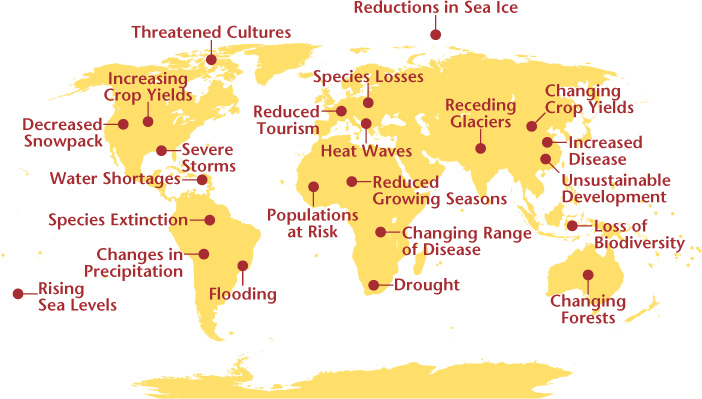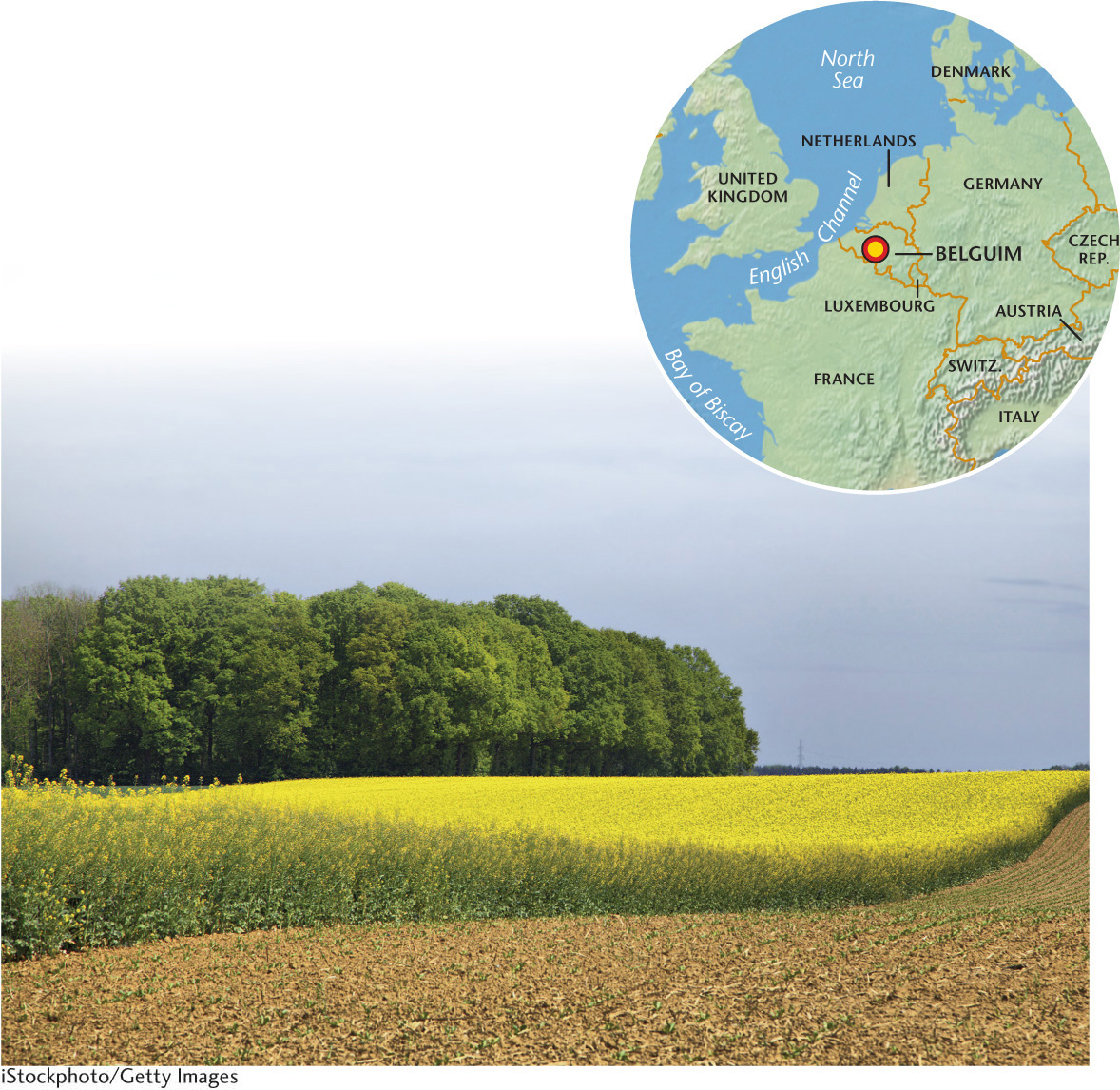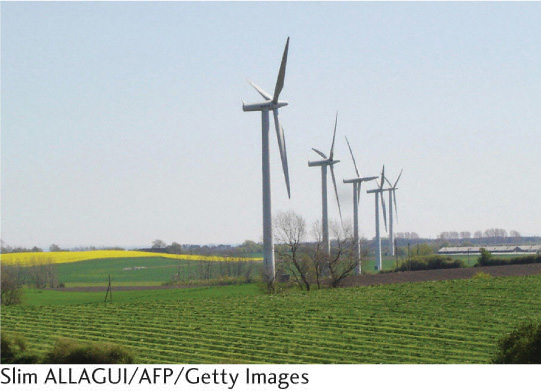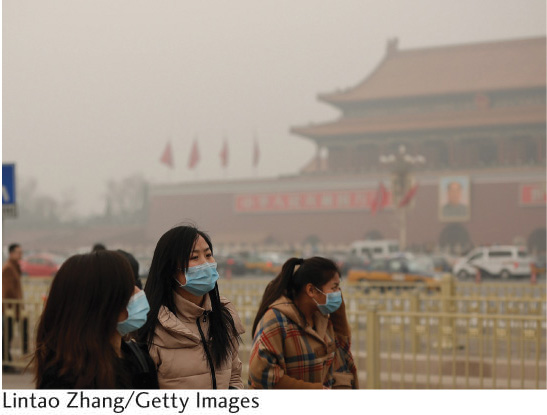NATURE-CULTURE
9.4
LEARNING OBJECTIVE
Recognize the role that nature has played over time as concepts and practices of development have changed.
As we have seen already in this chapter, the extraction of natural resources from the Earth, and their subsequent transformation through manufacturing into products that people need and want, have for centuries been the engine of economic development. Nature, in other words, is transformed into (material) culture. Nature is also transformed symbolically into culture. Specifically, “pristine” natural environments (see Figure 9.8, for example) are cultural images often positively associated with poorer places on the planet. It is as if a loss of purity, both of the natural world and of man’s place in nature, is the primary trade-off of economic development. Some scholars would go so far as to say that we have tacitly agreed to the ongoing destruction of the planet in exchange for living comfortably today, for most economic activity creates serious ecological problems. Thus, nature-culture is a very important theme to explore with respect to development geography.
RENEWABLE RESOURCE CRISES
Human beings have a long history of depleting the natural world around them, in the name of progress. Deforestation, for example, has been a problem since the beginning of human civilization. Ancient humans used fire to burn down trees and drive woodland animals out of the forest in order to more easily hunt them. Neolithic-era agriculture involved clearing forest land for cultivation (see World Heritage Site). The ancient Greeks faced problems with the silting of their harbors as the lands cleared for domestic crop cultivation eroded, a scenario also experienced by the ancient Romans and medieval Europeans. Cities were often abandoned when their ports became unusable. Europe’s heavy involvement in the trans-Atlantic slave trade, warfare, and voyages of exploration to distant lands resulted in massive deforestation of Northern forests in order to build wooden ships for these activities.
It might seem that only finite resources are affected by industrialization, but even renewable resources such as forests and fisheries are endangered. The term renewable resources refers to those primary sector products that can be replenished naturally at a rate sufficient to balance their depletion by human use. But, that balance is often critically disrupted by the effects of industrialization. So, while deforestation is a longstanding process, the Industrial Revolution drastically increased the magnitude of the problem. Today, the Earth Policy Institute has identified Latin America as the region experiencing the greatest loss of forest cover, thanks primarily to tree clearance in the Amazon to make way for cattle ranches. Indeed, we are witnessing the rapid destruction of one of the last surviving great woodland ecosystems, the tropical rain forest. The most intensive rain forest clearing is occurring in Indonesia and Brazil. Although trees represent a renewable resource when properly managed, too many countries are, in effect, mining their forests at a rate faster than they can be replaced. Even when forests are replaced by scientifically managed “tree farms,” as is true in most of the developed world, ecosystems are often destroyed. Natural ecosystems engender plant and animal diversity that cannot be sustained under the monoculture of commercial forestry.
renewable resources
Those primary sector products that can be replenished naturally at a rate sufficient to balance their depletion by human use.
397
Similarly, overfishing has brought a crisis to many ocean fisheries, a problem compounded by the pollution of many of the world’s seas. On average, people consume four times as much fish as they did in 1950, reaching an all-time high of 37 pounds (17 kilos) per person annually in 2011. More than 85 percent of the world’s fish stocks are compromised by overfishing. A BBC report suggests that “large areas of seabed in the Mediterranean and North Sea now resemble a desert—the seas having been expunged of fish… .” Commercial fishing methods are now depleting the world’s tropical waters as well, with a 40 percent drop in tropical fish catch expected by 2050. As with tree farms, fish farming has significant drawbacks, including pollution of the surrounding waters from the antibiotic and fecal waste of the concentrated fish farm populations, along with a lack of nutrients in the meat when farmed fish are fed vegetarian diets. Some good news was reported in the North Sea, though: since 2009 the size of the spawning stock of cod reached a level that scientists agreed was sustainable. Experts credited an array of conservation techniques for the turnaround.
GLOBAL CLIMATE CHANGE
Virtually all climate change scientists now agree that we have entered a phase of global climate change (commonly called global warming) caused by human activity and, most particularly, by the greatly increased amount of carbon dioxide (CO2) produced by burning fossil fuels. (However, see Subject to Debate in Chapter 1 to examine more fully why some disagree about the extent to which industrial activities contribute to the increase in CO2.. See also Chapter 10.) Fossil fuels—coal, petroleum, and natural gas—are burned to create the energy that powers the world’s factories, and as that burning has increased, so has the amount of CO2 released into the atmosphere. The 10 hottest years on record have all occurred since 1998. Rising sea surface temperatures melt Arctic ice. The extent of the Arctic Sea ice measured by NASA in 2012 was the smallest ever recorded. Melting ice raises ocean levels, threatening to obliterate coastal areas and even entire countries, such as the island nation of Maldives. Thanks to global climate change, some areas of Earth are hotter, wetter, drier, or colder than normal. As displayed in Figure 9.30, these changes have led to disruptions in agriculture, weather, tourism and leisure activities, and human health.
global climate change
Also known as global warming, global climate change involves alterations in climate caused by human activity and, most particularly, by the greatly increased amount of carbon dioxide (CO2) produced by burning fossil fuels.

At issue is the so-called greenhouse effect. Every year automobiles and industry produce billions of tons of CO2 worldwide by burning fossil fuel. By some estimates, the atmospheric concentration of CO2 has climbed to the highest level in 180,000 years (Figure 9.30).
greenhouse effect
The effect of increased atmospheric carbon dioxide and other absorbing gases, which permits solar shortwave heat radiation to reach the Earth’s surface but acts to block or trap long-wave outgoing radiation, causing a thermal imbalance and global heating.
398
In addition, since trees absorb carbon dioxide, the ongoing destruction of the world’s rain forests adds huge additional amounts of CO2 to the atmosphere. Although CO2 is a natural component of the Earth’s atmosphere, the freeing of this huge additional amount is altering the chemical composition of the air. Carbon dioxide, only one of the absorbing gases involved in the greenhouse effect, permits solar short-wave heat radiation to reach Earth’s surface but acts to block or trap long-wave outgoing radiation, causing a thermal imbalance and global heating.
To begin to mitigate the effects of the environmental crises caused by global climate change, 38 industrialized countries signed the Kyoto Protocol in 2001. This document, originally discussed in Kyoto, Japan, in 1997 and renewed in Durban, South Africa, in 2011, binds these countries to reducing emissions of greenhouse gases so that their future levels of emissions will be less than their 1990 levels. The United States agreed to this protocol in 1997, but has since changed its position and is no longer a party to the agreement, claiming that it would cause economic setbacks and does not do enough to curtail the high emission rates of poor nations. It is true that the large emerging economies in the Global South discussed earlier are also adding quickly to the world’s greenhouse gas emissions, and these nations must be central partners in any agreement to address global climate change. For this reason, Mexico, South Africa, Qatar, and South Korea have recently hosted or are scheduled to host global climate change summits.
World Heritage Site: Neolithic Flint Mines at Spiennes
World Heritage Site
Neolithic Flint Mines at Spiennes
Two hundred and ninety seven of the UNESCO World Heritage Sites pre-date the modern era, and are considered ancient places having outstanding universal value to humankind. The Neolithic flint mines at Spiennes is one such place. Located near the city of Mons, modern-day Spiennes is a small village in Wallonia, a French-speaking region in southern Belgium. Spiennes dates back to the middle Neolithic period (4400-3500 b.c.e.) in central Europe. Associated with the ancient settlement above ground is a vast complex of mine shafts from the same period.
◼ The mines span an area of over 100 hectares and represent the largest concentration of early primary sector activity in Europe.
◼ The mine shafts are among the deepest ever sunk anywhere to retrieve flint.
◼ The area was actively mined from 4400 to 2000 b.c.e., though there is some evidence of human activity prior to that, as early as 6000 b.c.e.

◼ The Neolithic era was a turning point in the development of technology for human progress, which is why the flint mines at Spiennes are designated as an Industrial Heritage Site.
◼ The mine complex is the earliest and largest example of primary sector activity in Europe.
◼ The Neolithic flint mines at Spiennes were designated a World Heritage Site in 2000.
399
TECHNOLOGY AND DEVELOPMENT: The Neolithic era, also known as the New Stone Age, was a pivotal one in human history. It saw the domestication of crops and animals, and coincided with the development of early cities (see Chapter 10). The tools developed during this period were made of stone—the Metal Ages would come later. Flint proved to be an exceptionally useful material as it can be worked into a very sharp edge through a process known as “knapping” and polishing. The first flint tools were hand-held; later, wooden handles were added to make axes.

◼ As discussed in the nature-culture theme for this chapter, the Neolithic period saw the rise of agriculture and the related clearance of vast areas of forested land across Europe and the Mediterranean. The felled timber was used in the construction of housing and boats. The axes—known as the Swiss army knives of their time—were used to fell trees as well as for hunting and mining. Many were constructed of the flint mined at Spiennes.
◼ As you know from reading this chapter, industrial activities are an important component of development. Mining is a primary sector activity because it involves the extraction of raw material from the Earth. Large flint nodules were extracted from underground at Spiennes using flint picks, deer antler, and cow bone.
TOURISM: Some ancient World Heritage Sites, such as Stonehenge in England and the Pyramids at Giza, Egypt, are visited by thousands of tourists annually. Others, such as the Neolithic flint mines at Spiennes, are by contrast off the beaten path. Until quite recently, the mines had hardly been marked and were difficult for tourists to find. The mine shafts remain almost entirely untouched, except for some that have been fortified to accommodate the visits of tourists.

◼ Only a few hundred tourists visit the Neolithic flint mines at Spiennes annually, often on a day trip that is part of a broader tourist itinerary in the area.
◼ A modern visitors center is under construction and scheduled to open in 2015; it is hoped that this will help to attract more tourists.
◼ Guides lead tourists down into a mine shaft, approximately 26 feet (8 meters) deep, to explore a section of the underground labyrinth.
◼ The area above ground is littered with tailings, which are left-over scraps of flint generated during the knapping process thousands of years ago.
400
THE ENVIRONMENTAL CONSEQUENCES OF POWERING INDUSTRIALIZATION
The extraction of natural resources from the Earth, and their transformation into the myriad consumer goods we now rely on, depend on the provision of energy to run factories and transport finished products. Consumers the world over have grown accustomed to heated and cooled dwellings, artificial lighting, and running water, among other amenities. The agricultural activities needed to feed the world’s more than 7 billion inhabitants require plenty of power as well.
So-called alternative energy sources—that is, alternatives to fossil fuels—have long been pursued in an attempt to provide cleaner, cheaper, renewable power sources. These alternatives include hydroelectric, solar, wind, geothermal, nuclear, biofuel, and “clean” coal. However, the expense involved in building, running, and maintaining sites for harnessing and distributing these power sources; their intermittent nature in some cases, such as solar and wind; and the potential hazards associated with some of them have deterred their widespread adoption. As a result, the world still relies heavily on fossil fuels to power economic activities: 80 percent of the world’s energy, in fact, still comes from fossil fuels. Not incidentally, powerful oil, gas, and electrical industry groups have spent millions of dollars to lobby politicians, especially in the United States, to reject policies favorable to alternative energy. The advent of hydraulic fracturing (fracking)—which uses pressurized liquid to fracture rock in order to extract natural gas and petroleum—is the latest example of how the United States has, as a nation, largely chosen to continue to extract fossil fuels rather than switch to other fuel sources.
alternative energy
Alternatives to traditional fossil fuels, including hydroelectric, solar, wind, geothermal, nuclear, biofuel, and “clean” coal.
As the emerging nations of the Global South become increasingly important producers of goods and services, how they choose to fuel their economic growth will be of paramount importance. As we have already seen, South-South cooperation in alternative environmental technologies is an important growth area for these emerging economies. It is entirely possible that the next wave of alternative energy ideas will emerge from technical innovations developed in the Global South. Lesotho exports water to South Africa, while Paraguay, Bhutan, and Mozambique are all net exporters of electricity to neighboring countries.
Some nations in wealthier Northern regions of the world are also noted for their use of renewable energy. Iceland, the world’s largest volcanic island, has abundant geothermal and hydro power. Iceland’s electricity is clean: it is produced entirely by renewable energy. Samsø, an island off the coast of Denmark, has become a wind power showcase for the world. Hot water is produced by wood chips and straw provided by local farmers, as well as by solar panels. As a result, Samsø can boast its status as carbon-neutral and a net exporter of clean electricity (Figure 9.31). Nations the world over—North and South—are at the vanguard of developing alternative energy sources to fuel their activities.

401
China’s Harmful Air Quality China provides an example of the negative environmental consequences of industrialization. Rather than pursuing clean, alternative, innovative sources of energy, China has decided to chart the same course, energy-wise, as the now wealthy nations of the North did to fuel their industrial development. In 2006 China’s greenhouse gas emissions exceeded those of the United States for the first time, and the gap has continued to accelerate since then. China is now the world’s biggest emitter of pollution.
The resulting air contamination has caused regular shutdowns of businesses, public places such as schools, and transportation venues from bus service to international airports in cities such as Shanghai and Beijing (Figure 9.32). Not only is human health severely affected by the thick soup of particulate matter given off by cars, buses, household heating and cooking, and industry; visibility is also reduced so much that drivers cannot see across a roadway, or a pilot down a runway to safely land a plane. On a particularly bad day in October 2013, the level of fine particulate matter—those particles small enough to lodge deep inside human lungs—as measured in the northeastern city of Harbin was 40 times higher than the international safety standard set by the World Health Organization.

China’s air (and water and ground) pollution is the result of its rapid, sustained rate of economic growth, which has averaged 10 percent annually since the late 1970s. This growth has lifted many Chinese out of poverty, and has transformed the country’s cultural landscape from a primarily rural to a primarily urban one. Yet, the economic toll when business and transportation activities must be halted due to contamination is steep, as are the long-term costs to human health. The National Academy of Sciences reported that a person alive in the 1990s in northern China will live, on average, 5.5 years less than her counterpart in southern China. This is directly attributable to air contamination in northern China where industrial activities are centered. During the harsh northern winters, people routinely burn traditional (not “clean”) coal—a highly contaminating fuel source—to keep warm. Financial experts attribute the recent slowdown in China’s economic growth, to around 7 percent in 2012, to the economic costs of pollution resulting in disruptions to business, protests leading to factory closures, and increased health care expenses.
402
In 2012 China released a national plan to reduce its carbon emissions and to utilize more nonfossil fuels. In addition, the large northern industrial cities are participating in a carbon cap and trade program. These programs limit (cap) carbon emissions and lower the limit over time, as well as providing economic incentives for companies to find innovative ways to remain below their carbon cap. If a company finds it difficult to meet its cap, that company can buy allowances from other companies that find it easier to reduce their emissions. In this case, a sort of “carbon market” develops.
carbon cap and trade
Programs that limit (cap) carbon emissions, and lower the limit over time, as well as providing economic incentives for companies to find innovative ways to remain below their carbon cap.